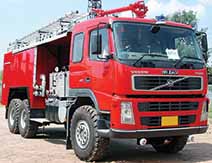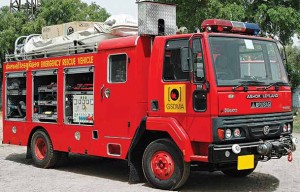Brijbasi Hitech Udyog commands a good 30 per cent market share in fire fighters.
Story by:
Anirudh Raheja
Brijbasi Hirech Udyog was established in 1971 with an aim to redefine the fire fighting industry and supply quality products. Serving oil refineries, pharma companies, fertilizer complexes, thermal power projects, state fire brigades, municipal fire brigades, steel plants, port trust organisations, civil aviation bodies and atomic energy establishments, the company has till date delivered more than 7000 fire fighting vehicles. The count also includes vehicles that were exported. Commanding a 30 per cent market share in the domestic market, the company, according to Arun Bhatnagar, General Manager, Sales and Marketing, Brijbasi Hitech Udyog Ltd (BHTUL), goes the extra mile to understand the requirements of the customer and how a certain vehicle platform will be suitable. Fetching a significant order to supply 60 crash fire trucks to the Airport Authority of India in 1975 according to Bhatnagar, the company refrains from offering what they have, and instead pay attention to what the customer requirement is. Having supplied more than 150 fire crash tenders to the Indian Air Force, BHTUL has fabricated 110 crash fire tenders for the Indian Air Force through Bharat Earth Movers (Bangalore) as well.
Meeting the standards
Serving diverse clients, BHTUL has to comply with various regulations as it builds and supplies fire tenders. The regulations include specifications set by the Bureau of Indian Standards for fire tenders (IS 960 and 6067), for foam tenders (IS 951 and 10460), for medium capacity dry chemical powder tender (IS 10993), air crash fire tenders (IS: 951/ ICAO/NFPA or International standard/Ministry of Defence) and for defense vehicles under the DRDO and DGQA. Mentions Bhatnagar that the clients that they serve as different as cheese and chalk. “The requirement of BPCL, IOCL and HPCL could be far different from the requirement of a thermal power company like NTPC, or that of an electricity board,” he says. The requirements of muncipalities for fire tenders could be far different, Bhatnagar emphasises.
Serving heavy industries like the Durgapur, Bokaro, Bhillai and Visakhapatnam steel plants, BHTUL has supplied fire tenders to the state fire services of Maharashtra, Assam, Jammu & Kashmir, West Bengal, Uttar Pradesh, and others. The company recently executed an order of 38 water mist systems or quick response vehicles. These were supplied to the Kerala Fire services. BHTUL recently supplied 100 medium water tenders to IOCL and BPCL refineries. Opining that the setting up of National Disaster Management Authority in 2005 has led to the elevation of safety awareness, Bhatnagar states that the demand for quality is increasing. “The demand for quality is increasing putting us in a position of advantage since we have always strived for the highest quality standards in all our endeavours,” Bhatnagar expresses. He explains, “The hazardous nature of the job demands minute attention to quality.”
Apart from the demand for quality, BHTUL has had to account for a change in vehicle chassis. Avers Bhatnagar, “Vehicle setup has been changing.” BHTUL chooses the vehicle chassis for a fire fighting job as per the class of fire it is expected to deal with. Fire tender vehicle chassis may be of the single cab type or of the double crew cab type. Their tonnage could be in the 25-tonne range. Chassis are typically sourced from Tata Motors, Mahindra, Ashok Leyland and Eicher. For high end operations, BHTUL procures chassis from Volvo, MAN and Mercedes-Benz. “The non-availability of requisite chassis from Indian OEMs for high end operations drives us to international OEMs,” reasons Bhatnagar. The variety of fire tenders that BHTUL supplies include water tenders, water bousers, foam tenders, dry chemical powder tenders, rescue tenders, hi-tech foam tenders, crash fire tenders, defence vehicles, aerial platform vehicles, and vehicles carrying water mist system informs Bhatnagar. Almost each and every fire tender is tailor-made to the specifications of the industry.
Building a fire tender
Inking an agreement with Finnish firm Bronto Skylift Oy Ab in 1984 for aerial ladders, BHTUL supplied over 100 hydraulic platforms ranging from 23 m to 112 m. The company commenced the assembly of CKD kits at its facility at Mumbai. Platforms of up to 42 m began manufacture. Platforms ranging from 42 m to 112 m continue to be imported. The ones that are assembled, follow the EN 1777 and CE standards. Patforms below 45 m are engineered at the back of the Tata or Ashok Leyland truck chassis. Platforms above 45 m are installed on a Volvo or Mercedes-Benz chassis. Avers Bhatnagar, “Power Take-Off (PTO) challenge lies in maintaing the height and water pumping capacity.” The system has to pump water at pressure to a certain height. Chassis power often proves more than enough. No change is effected to the chassis expect for some fabrication undertaken as per the customer requirement. “Anything touched on the chassis level can change the centre of gravity and compromise vehicle balance. This would lead to the rejection of the vehicle,” mentions H. B. Suresh, General Manager – Hitech Vehicles, Brijbasi Udyog.
Subject to fitness test every three years, a fire tender takes 30 days to build. Some 300 parts are required. The challenge is to source high quality components from trusted sources, according to Bhatnagar. Supported by 200 vendors, BHTUL sources aluminium from Hindalco and stainless steel material from Tata steel. “With over 60 per cent of the vehicle occupied by the tank carrying fire extinguishing material, any compromise in quality can jeopardise the whole operation,” mentions Suresh. Designed and built to fight fire over longer durations and disperse water quickly, fire tenders require high quantity fire extinguishing material. In the case of a water bowser, explains Suresh, the tank covers 80 per cent of the vehicle chassis. The impetus on quality is therefore quite high. Developing mild steel or stainless steel tanks that carry fire extinguishing material of capacities ranging from 1000 litres to 18000 litres, and as per the customer requirements, the company pays particular attention to the chassis.
Once ready, the fire tender is subjected to rigorous testing by BHTUL. This is followed by a demonstration of the vehicle at the customer. Only after the customer tests the vehicle, and is satisfied, is the final inspection certificate issued. Training the customer staff to operate the vehicle, the company also undertakes annual maintenance contract. Its executives visit the customer and conduct health checkup of the vehicle every six months to ensure optimum performance and suggest ways to overcome any challenges the customer is facing. “In case the customer wants to handle multiple jobs, we also supply tenders with two extinguishers like foam and water, or even with CO2,” informs Suresh. Water is a general fire extinguisher whereas foams are used in petrochemicals, oil spillage and petroleum fire. Dry chemical powder (DCP) is used to put off electrical fires. Expresses Suresh, that State fire brigades are well aware of their needs, and have an acute understanding of their needs. Every state follows different standards, says Bhatnagar.
Infrastructure
BHTUL has three manufacturing facilities. Of these, two are located at Mathura, and one is at Mumbai. All combined, the facilities have a covered area of 10000 sq. yards. The infrastructure of BHTUL also includes 20 acres of open land to conduct performance test, and to park vehicles. The Mathura facilities can together roll out 100 vehicles per annum. As per the market demand, production can be scaled to 150 vehicles. The Mumbai facility is younger than the Mathura facility, and can build 50 vehicles per annum. Production could be scaled up to 100 vehicles depending on the demand. At Mathura, BHTUL has also invested in a reasearch and development facility. Close to ten per cent of the revenues, the company spends on research and development, Employing 150 people, BHTUL has setup a college at Mathura to train people in fire safety and disaster management. “Depending upon the need or the requirement, the course duration varies from six months to two years,” mentions Bhatnagar. He concludes, “We are not just building fire tenders, we are also training people
to prevent fire, protect and rescue.”




























